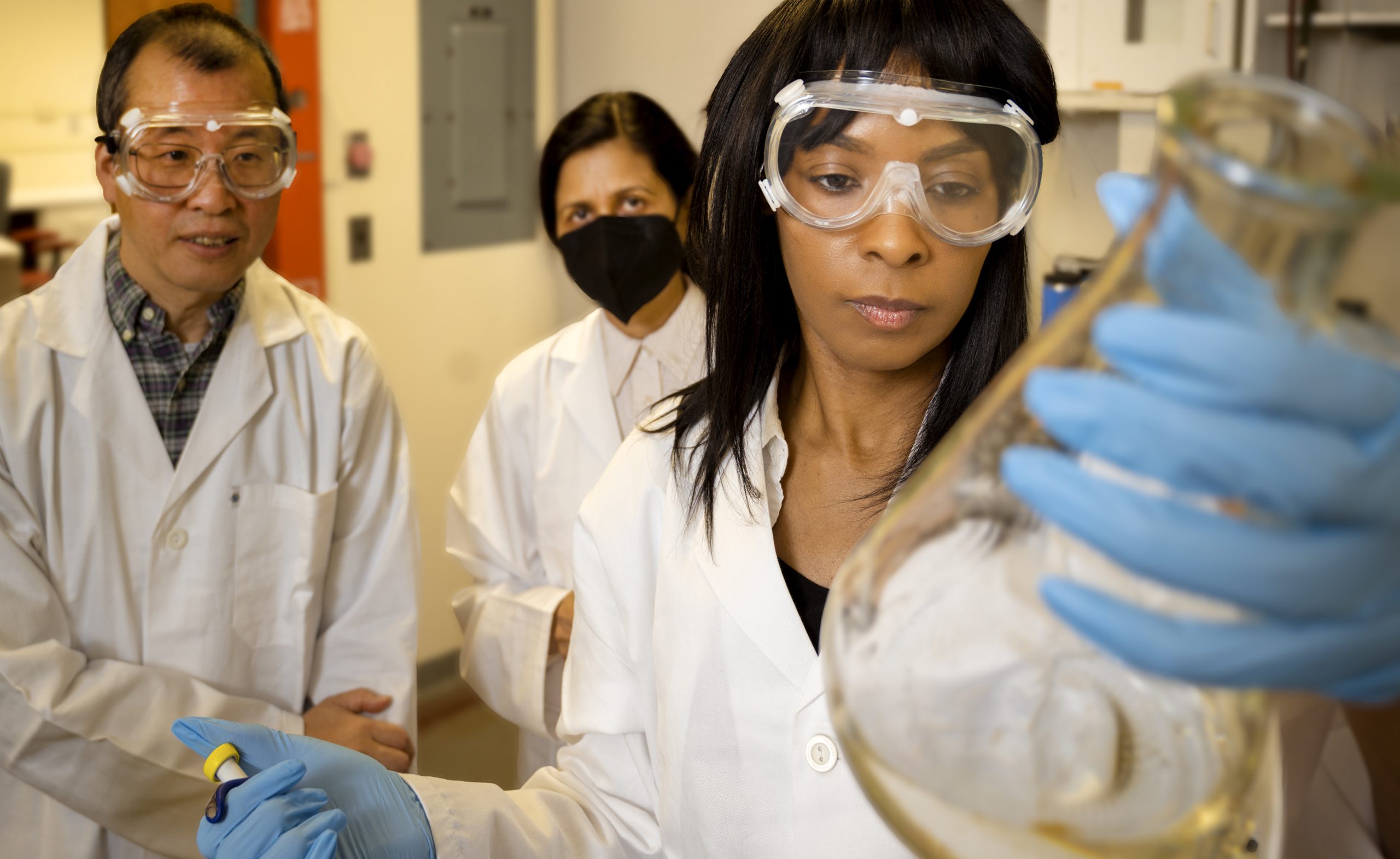By: Eric Addison
“You are eating a credit card’s worth of plastic every week!”
Variations on that headline were effective attention-grabbers, even in the crowded news media of the time. But were they factual?
The jury of real scientists is still deliberating that, says Scott Knoche, Ph.D., director of Morgan State University’s (MSU’s) Patuxent Environmental and Aquatic Research Laboratory (PEARL), in Calvert County, Maryland. More certain, Dr. Knoche says, is that, “It’s innately concerning to people, because it’s in the water we drink, the food we eat…. It’s something that is very salient to us. It’s a really important and frightening problem.”
The topic at hand for Knoche and MSU Professor of Biology Chunlei Fan, Ph.D., is the increasingly well-publicized subject of “microplastics” and their incidence in environmental pollution in the United States and around the world. Plastics are the most prevalent types of marine debris found in oceans around the U.S. and in the Great Lakes, according to the National Oceanic and Atmospheric Administration (NOAA). But research of the human impact of microplastics, defined as pieces of plastic less than five millimeters (.2 inches) in length, is still in its infancy. Four years ago, science educators at Morgan decided to make their historically Black institution a leader in the field.
Dr. Fan, Dr. Knoche and Hongtao Yu, Ph.D., now MSU provost, then dean of Morgan’s School of Computer, Mathematical and Natural Sciences, huddled to find a common research focus for the University’s Biology Department, Physics Department, Chemistry Department and PEARL.
“We wanted to leverage the synergy of all our activities and infrastructure to work on an important, current research topic,” recalls professor Fan, who also serves as director of Morgan’s Bioenvironmental Sciences Ph.D. program. “We decided to target microplastics research.”
We said, ‘Let’s look at microplastic abundance and distribution in the Patapsco River in Baltimore and in the Patuxent River near the PEARL.’ It’s bringing our unique resources to bear to produce some cool research most universities wouldn’t be able to do because they don’t have an asset like PEARL.
–Scott Knoche, Ph.D., Director, MSU Patuxent Environmental and Aquatic Research Laboratory
“We have our main campus in northeast Baltimore and our PEARL lab in southern Maryland,” adds Knoche. “Microplastics are ubiquitous in the environment. We said, ‘Let’s look at microplastic abundance and distribution in the Patapsco River in Baltimore and in the Patuxent River near the PEARL.’ It’s bringing our unique resources to bear to produce some cool research most universities wouldn’t be able to do because they don’t have an asset like PEARL.”
Microplastics pollution seems a perfect match for the type of challenging societal problem discussed in Morgan’s 10-year strategic plan: one that could lend itself to innovative, interdisciplinary solutions developed by the University. Morgan’s research of the problem has multiple aims, Dr. Fan reports: (1) to learn the concentration, abundance and distribution of microplastics in the Chesapeake Bay and (2), to identify the major source of the microplastics in the bay, by comparing water samples from the Patuxent River, near PEARL, with samples from Baltimore City, the home of Morgan’s main campus.
Morgan has been successful in starting and expanding this work. Dr. Fan headed a team that wrote a proposal for the National Science Foundation that resulted in a three-year, $1-million grant from the agency in February 2021. One third of the funding goes to the University to cover indirect costs, Fan reports, and the lion’s share of the remainder goes to the students doing the research: four Ph.D. students and one postdoctoral research associate. An additional external grant of about $60,000 from Shimadzu Scientific Instruments enabled the purchase of a special microscope that is vital to the NSF-funded work. Morgan also landed a $15,000, two-year grant for a pilot study of microplastics accumulation in the bodies of oysters. The ultimate goal of that research, made possible by PEARL’s oyster hatchery and oyster aquaculture programs, is to begin to determine how microplastics can affect human health.

Home-Grown Resource
Tameka Taylor, MSU Bioenvironmental Sciences Ph.D. candidate, is one of the four doctoral researchers whose work is being funded by the NSF grant. Born and raised in Baltimore City’s Franklin Square neighborhood, and a product of the city’s public schools, she began her post-collegiate career as a middle school math and science teacher, in 2010, and now works at the United States Environmental Protection Agency.
“I’m actually a chemist,” fulfilling the career dream she has had since she was age 9, Taylor explains. “I am looking at how to strategize and build relationships, across the U.S. government and with stakeholders, to minimize or reduce the plastic waste going into oceans and waterways.”
Becoming a doctoral student at Morgan in 2020 was a homecoming for Taylor, who pursued her bachelor’s degree in chemistry for three years at MSU before transferring to another university for her last 30 credits. Her introduction to environmental science came during an internship with Morgan chemistry professor Santosh Mandal, Ph.D., helping develop a process to stabilize radioactive waste in underground storage containers dating from the Cold War. Today, the mother of three is looking forward to 2025, when she expects to reach her lifelong goal of receiving a Ph.D. and begin taking advantage of greater opportunities to support young, up-and-coming scientists.
Taylor holds nothing back in expressing her gratitude to Morgan.
“Morgan is my foundation, and I have such a love for Morgan and what Morgan has afforded me,” she says. “I hope that one day I can truly give back to the school what it has given me.”
I want to further understand the relationship microplastics and these chemicals have, because the chemicals are able to catch a ride on the microplastics, which sometimes wind up in our food supply, in our drinking water and then ultimately can have negative impacts on human health.
-Tameka Taylor, MSU Bioenvironmental Sciences Ph.D. Candidate
Important Findings
The COVID-19 pandemic delayed Morgan’s microplastics research considerably, Fan admits, but the projects have produced important knowledge, even so.
“This summer, we did an experiment on how microplastics affect oyster larvae development,” Fan reports. “Our preliminary results suggest that the microplastics can delay the larvae’s development. Basically, under normal conditions, it takes about two weeks for the oyster to go from spawning to settlement. But with the microplastics addition, it may take two and a half or three weeks. We’re planning to present our findings at a scientific conference in Washington, D.C., next year.
“Another recent finding came from our use of a different type of sampling protocol that allowed us to collect smaller microplastic particles in the Chesapeake Bay. And our preliminary results suggest there are many, many more small microplastic particles than the large particles that we collected in the previous study,” he continues. “So we might have a bigger microplastic pollution problem than we previously thought.”
Taylor concurs. She says her research at PEARL, and her role as a parent, have given her a greater sense of urgency about her work.
“One thing that’s surprising to me, across the board, is how polluted our environment is. I mean pollution from so many different chemicals. It is amazing to me how we’ve mismanaged resources,” Taylor says. “…I was never that parent to say to my kids, ‘Just drink water,’ because it made me feel guilty, knowing that our water is polluted. There are some measures you can take, right? You can use activated charcoal to filter your water at home. But we need policy. We need people in high places to change the course of what’s going on. I think we should do what we can do at our level, but we definitely need interventions that are higher up. And we need them now.”
…Our preliminary results suggest there are many, many more small microplastic particles than the large particles that we collected in the previous study. So we might have a bigger microplastic pollution problem than we previously thought.
–Chunlei Fan, Ph.D., Professor of Biology and Director of Bioenvironmental Sciences, MSU





